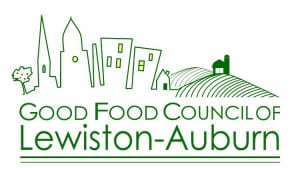We hope that these documents serve as valuable resources for the community to better understand the local food system, as well as food system work in general.
Community Food Assessment – Supplemental Reports
- Direct Producer-to-Consumer Marketing: A Feasibility Study for Increasing Local Food Access to Limited Income Communities in Lewiston-Auburn, Maine (pdf, 1.3MB)
K. Ullman, Bates College
Examines direct producer-to-consumer marketing, studying the feasibility of increasing local food access for limited income communities in Lewiston and Auburn.
- The Community Farm: Analysis of Farm Models Throughout the Nation (pdf, 700kb)
Friedman, et al, Bates College
Focuses on the benefits that urban farms hold for areas like Lewiston-Auburn: enhancing sense of community, producing food, offering opportunities for education, job skill-building, employment, and community self-reliance.
- Returning to Our Roots: Addressing Food Insecurity in Lewiston/Auburn, Maine with an Urban Farm Project (pdf, 700kb)
A. Doran, Southern New Hampshire University
Focuses on the benefits that urban farms hold for areas like Lewiston-Auburn, and to the capacity and need of the L-A area to work toward creating an urban farm.
- Demographic Data and Stories of Food for Families with Children in Hillview and River Valley Village Housing Communities (pdf, 370kb)
Agins, et al, Bates College
Captures the challenges of childhood hunger in Lewiston and identifies major themes related to food insecurity at two housing communities in Lewiston.
- What Does It Take: Making Nutritious Food Accessible to Immigrants and Refugees Living in Lewiston, Maine (pdf, 1MB)
Goulding, et al, Bates College
Provides valuable suggestions for dealing with the unique food insecurity challenges faced by Lewiston’s population of Somali immigrants.
- Addressing Food Insecurity through Corner Stores: Developing a Foundation for Lewiston, Maine (pdf, 555kb)
Dunn, et al, Bates College
Explores the healthy corner store initiatives and programs that have developed throughout the country in an effort to increase healthy food options in small neighborhood stores.
- Elderly Food Insecurity in Lewiston, Maine (pdf, 570kb)
Antell, et al, Bates College
Examines how food security impacts Lewiston’s elderly and identifies five critical components of food insecurity impacting this population: isolation, physical decline, bad habits, economic stress and level of education.
- 2012 Food Action Charrette Report (pdf, 298kb)
Summarizes an event that allowed the community to express its priorities in regards to the food system, and to suggest actions and key partners for working toward those priorities.
Food Council Resources
- List of Food Policy Councils in North America (pdf, 423kb)
Community Food Security Coalition
Updated in 2012, this provides a state-by-state listing of food councils throughout the nation and in Canada. A map of these councils may be seen here.
- Doing Food Policy Councils Right: A guide to development and action (pdf, 4.8MB)
Mark Winne Associates
Produced by one of the most recognized names in the food system/food council world, this helpful document offers information about what food councils are, what they can do, and how to bring one together. Focused on councils that deal mostly with policy work.
- Good Laws, Good Food: Putting STATE Food Policy to Work for our Communities (pdf, 3.3MB)
Good Laws, Good Food: Putting LOCAL Food Policy to Work for our Communities (pdf, 2.7MB)
Harvard Law School Food Law and Policy Clinic
These toolkits provide guidance on how to work with the legal and policy frameworks of states and municipalities to make improvements to the food system. They help to build an understanding of general legal settings, and recommend specific policies for changing different parts of the food system.
- Planning for Food Access and Community-Based Food Systems: A National Scan and Evaluation of Local Comprehensive and Sustainability Plans (pdf, 6.3MB)
American Planning Association
This study reviews local comprehensive and sustainability plans across the United States that include food-related goals, and looks at how those plans have helped to improve food access and local food systems.
